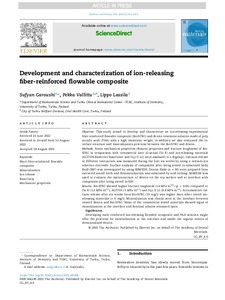Development and characterization of ion-releasing fiber-reinforced flowable composite
Garoushi Sufyan; Vallittu Pekka; Lassila Lippo
https://urn.fi/URN:NBN:fi-fe2022091258801
Tiivistelmä
Objective: This study aimed to develop and characterize an ion-releasing experimental fiber-reinforced flowable composite (Bio-SFRC) and dentin treatment solution made of poly(acrylic acid) (PAA) with a high molecular weight. In addition we also evaluated the interface structure and mineralization potential between the Bio-SFRC and dentin.
Methods: Some mechanical properties (flexural properties and fracture toughness) of Bio-SFRC in comparison with commercial inert (G-aenial Flo X) and ion-releasing materials (ACTIVA-BioActive Base/Liner and Fuji II LC) were assessed (n = 8/group). Calcium-release at different time-points was measured during the first six weeks by using a calcium-ion selective electrode. Surface analysis of composites after being stored in simulated body fluid (SBF) was investigated by using SEM/EDS. Dentin disks (n = 50) were prepared from extracted sound teeth and demineralization was simulated by acid etching. SEM/EDS was used to evaluate the microstructure of dentin on the top surface and at interface with composites after being stored in SBF.
Results: Bio-SFRC showed higher fracture toughness (1.6 MPa m1/2) (p < 0.05) compared to Flo X (1.2 MPa m1/2), ACTIVA (1 MPa m1/2) and Fuji II LC (0.8 MPa m1/2). Accumulative calcium release after six weeks from Bio-SFRC (15 mg/l) was higher than other tested ion-releasing materials (≈ 6 mg/l). Mineralization was clearly seen at the interface between treated dentin and Bio-SFRC. None of the commercial tested materials showed signs of mineralization at the interface and dentinal tubules remained open.
Significance: Developing such reinforced ion-releasing flowable composite and PAA solution might offer the potential for mineralization at the interface and inside the organic matrix of demineralized dentin.
Kokoelmat
- Rinnakkaistallenteet [27094]
